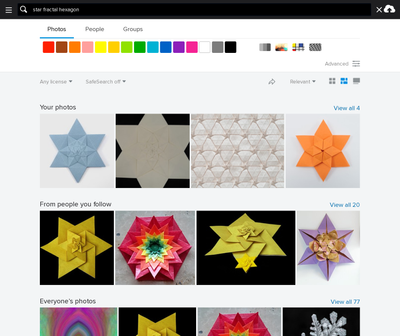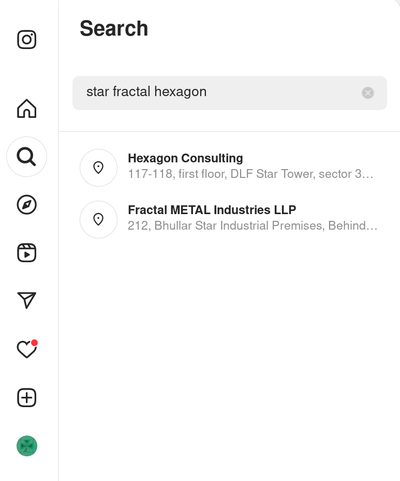Flickr, Instagram, and the Free Lunch

The good thing about serious problems is they don’t go away easily, and you can keep writing about them for a long time. This post is long overdue: I planned to write it in 2019 but didn’t find the time. It’s 2023, and all I wanted to write still holds. Additionally, being able to witness Twitter’s takeover by Elon Musk confirmed my worries about the fragility of social media and resulting disadvantages for the preservation of origami publications there.
The Story
For many years, Flickr was the main site where origamists published their images and discussed their designs. I don’t know what brought people there first: perhaps some veteran of that age can shed light on this. Anyway, at the time I decided to more often publish my origami online in 2015, Flickr was the place to go.
In late 2018, Flickr, which was struggling financially, was acquired by a new owner, and introduced a number of changes to their business model. Free accounts, which initially could host an unlimited number of images, were to be limited to 1000 pictures. This move was poorly received by many in the origami community. A number of people announced they would be dumping Flickr and moving their activity over to Instagram. An exodus followed, with more and more users gradually moving to Instagram. While there still is an origami community on Flickr, it’s just a shadow of its former self. In my view, at this point there are very few new people joining, and those left are mostly veteran users who did not want to leave the platform behind. Pretty much all have by now started Instagram accounts as well.
The Problem
I think the way the switchover happened was an interesting example of an emergent phenomenon: a big change that affects us all took place, and pretty much everyone took part, but no particular person’s actions can be said to have caused it, and each individual person’s contribution was very small. It was the sum of individual small decisions that had a big impact. Some people made the move consciously but many just followed suit in a chain reaction, a kind of panic if you will. At some point I myself also created an Instagram account despite having a negative view of the whole situation. Since the point of my social media presence was reaching people interested in origami, I wanted to be where those people were. I never stopped updating my Flickr profile, though, and actually at this point I decided to start paying for Flickr Pro.
Now to my main point: I think the origami community moving from Flickr to Instagram was a change for the worse. I believe that by choosing Instagram over Flickr, origami community has lost some important capabilities, and that the arguments for moving were based on a false premise. But I also blame Flickr for not being able to communicate their changes effectively since framing these changes a little differently would have caused much less backlash among users.

The main point of contention was Flickr limiting the number of pictures in free accounts to 1000 while Instagram does not have such a limitation. This sounds like a clear advantage for Instagram. However, there’s a very important difference in how the two sites operate. On Flickr, images can be accessed via the feed, the images of a particular user can be browsed, just as on Instagram, but Flickr also offers full-text search which allows finding even old images based on their attached text. This makes a world of a difference.
Full text search means that out of the 1000 images free accounts can store, all are actually available to others. Over the years, Flickr has accumulated a huge archive of origami history. Many times, by searching for phrases I though might describe a model, I was able to identify people designing models similar to mine, to find pictures and information about origami designs I had heard of but never seen, and even engage origami creators by discussing their older but still very interesting work.

On Instagram, in contrast, there is no full-text search. What you can find and access must appear in your feed which moves on very fast, or you have to remember who published what you are looking for, go to their profile, and scroll as long as necessary to find what you need. Good luck finding a model from a few years ago this way, especially if you don’t remember the designer. The closest Instagram has to search is hashtags, but these are useless for this task: you usually have just a few hashtags per post, and they are very generic, such as #origami. So, in theory you can post an unlimited number of pictures, but anything older than a few days is not accessible in practice unless you remember all details. Older stuff just goes down the memory hole and could as well not be there at all.
Thus, I think comparing 1000 images on Flickr and unlimited images on Instagram is actually comparing apples to oranges. I think Flickr should have highlighted this in their communication. I also think a thousand images is actually quite a lot. I have been posting rather intensely for the last 7.5 years and only reached around 900 images. I know many people were close to the limit, but still a limit of 1000 isn’t that low. And the company certainly needed some way to differentiate their paid and free offer.
No Free Lunch
Speaking of which, it is a sad fact of life, but things cost money to run, and running a large-scale social media site is not cheap. We have gotten accustomed to things being “free” on the internet, but there is no such thing as a free lunch. If something costs money to run, and it does, someone is paying for it. It might not be paid for with money, and it might be paid for by someone other than you, but it is being paid for by someone.
This someone may be different depending on the situation. In the case of open-source software, development may be performed by volunteers working on the software in their free time or by businesses investing into software which they believe brings them an indirect advantage through becoming popular. Either way, as the end user, you get the right to use, distribute and modify the software, which also means you can quit if you want to. In the case of most social media sites, the situation is quite different: money comes from advertisers and companies buying data about users’ behavior. This is not necessarily always bad, but we should be aware of it. Nobody is giving us Instagram or Facebook or Google Search for free, and we as users of these technologies are not the paying customer. Or, rather, we are not the customer paying with money. We pay with our time, our attention, and our readiness to be influenced or outright manipulated in any way the sites’ owners see fit. By the way, we often also grant these site the license to use anything we upload any way they please. As the saying goes, “if you’re not paying for the product, you are the product”. Meta, Facebook’s and Instagram’s owner, has been accused of practically all pathologies such a business model encourages. Flickr’s model of charging the site’s heavy users is more straightforward: those who use the site more, pay for it directly. While the price for Pro accounts may be too high for many people, free accounts still exist.
One more issue with social media (including flickr) is: terms of use and policies may change at any point. Rapid changes on Twitter introduced after Elon Musk bought the site clearly show that relying on any sort of stability or long-term commitment on the side of social media providers is a risky bet. The changes in Flickr’s policy described above also fall into this category. I don’t know what the future of Twitter or Instagram or Flickr will be, but just as these sites emerged at some point while GeoCities, immensely popular in late 1990-s, went down, so will at some point even the greatest social media sites fade into oblivion, taking all our meticulously built profiles with them.
The Solution
What can we do? Unfortunately, there is no simple solution. The damage has already been done: several years’ worth of origami history is only on instagram where it’s neither easily accessible nor searchable. Social media sites live by network effects: the more users a site has, the more others it attracts. It’s no different for the origami community: people who post want to post where their audience is, and the audience want to be where the creators are. It’s hard to knock this system out of equilibrium, and it usually takes a disaster such as the Flickr change of terms of service.
Inertia usually wins. So, people will not be going back to Flickr, and they won’t be easily persuaded to move to another platform, either. In the long term, Instagram will of course fade away as all sites do at some point. What its successor will be and whether it will be any better, is hard to tell. Anyway, before you consider switching platforms, do take into account whether your origami’s new home takes text seriously, whether old entries are easily accessible, and whether the data can be searched. Instagram has many disadvantages, but the next fashionable trend could be even worse.
You might believe people would be willing to move to a new platform, built especially with origami in mind, but I don’t think this is going to happen. Building a system like this, even at the limited scale needed by the origami community, is a huge and costly undertaking. Simple forums which are relatively easy to set up, unfortunately are not as convenient to use. Additionally, the non-origami users on either platform also contribute to its attractiveness to origamists: such people add to the number of followers and likes, and these are some of the mechanisms social media sites use to keep us hooked to our screens. I think the larger scale, and the resulting larger numbers of followers and likes were among the factors that made Instagram seem attractive compared to Flickr, even before the ToS change.
So, given this state of affairs, what can you do as an origamist? I suggest that if you create origami that you would like to be preserved for posteriority, you should set up a personal website. Building a big and complex site requires time and effort, but setting up something simple is relatively easy and often costs nothing. Your personal site will not drive much traffic and doesn’t give your users the opportunity to provide you with a constant stream of likes, but it is a place you control much more than your Instagram feed, and a place which might allow your designs to be found by search engines. You can run it in parallel to your social media as a kind of independent storage and a place which is likely to survive a mass exodus from one platform or another should it happen. And yes, I think having Flickr as one of those sites is actually a pretty good idea. Given the prominent role of text and the full-text search engine, I think a Flickr feed can be much closer to a personal blog/website than an Instagram or Facebook feed. It also still hosts the ten or so years of origami history from the period it was the main place origamists published their work, and I still go there to search for information from that time. After 2018, there’s a gaping hole in the record, and it will probably never be filled, but by placing a little more focus on preservation and diversification of where our origami is published, perhaps we can slowly build up a bit of an origami archive again.
[Update]: I learned the idea I described above even has a name: POSSE, which stands for Publish (on your) Own Site, Syndicate Elsewhere.
Another thing worth doing is you can usually download all your data from social media sites. The option to do say may be hidden deep within the menu structure, but usually it is there. Here are example guides for downloading your data from Flickr and from Instagram. If you download your data once in a while, you will have access to your images and text even if you have to switch platforms at some point. Reuploading such data to a new place may not be straightforward, but it will be possible to restore it, and you won’t be losing all of your history.
Summary
I believe that we, the origami community, made a mistake by moving from Flickr to Instagram. Instagram’s per-account storage is unlimited only on paper, while in practice Flickr’s 1000 images, even for those who actually reach this limit, is much better given that all those images can be searched and easily accessed. More than ten years of origami history is still documented on Flickr while after 2018, there is, and continues to be, a large hole in the record. Nothing comes for free, and the vision of unlimited free storage on Instagram was just a lure. It will probably not be possible to reverse the current trend. The best we can realistically do, is to use alternative sites in parallel to Instagram, preferably personal sites, not dependent on social media companies. The next best thing, will be — when at some point the time comes to move off Instagram en masse — to consider whether the alternative actually is better, and to check how it fares with regard to full-text search and the potential of preserving our precious origami for a long time.
Comments